Kinematics - Motion along One Dimension | 11th Physics : UNIT 2 : Kinematics
Chapter: 11th Physics : UNIT 2 : Kinematics
Motion along One Dimension
MOTION ALONG ONE DIMENSION
Average velocity
If
a particle moves in one dimension, say for example along the x direction, then

The
average velocity is also a vector quantity. But in one dimension we have only
two directions (positive and negative x direction), hence we use positive and
negative signs to denote the direction.
The
instantaneous velocity or velocity is defined as

Graphically
the slope of the position-time graph will give the velocity of the particle. At
the same time, if velocity time graph is given, the distance and displacement
are determined by calculating the area under the curve. This is explained
below.
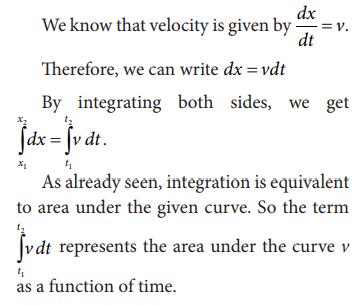
Since
the left hand side of the integration represents the displacement travelled by
the particle from time t1
to t2, the area under the
velocity time graph will give the displacement of the particle. If the area is
negative, it means that displacement is negative, so the particle has travelled
in the negative direction. This is shown in the Figure 2.35 below.
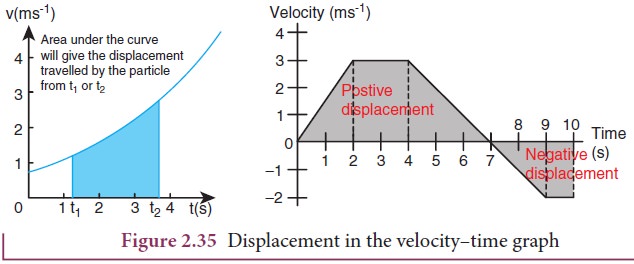
Relative Velocity in One and Two Dimensional Motion
When
two objects A and B are moving with different velocities, then the velocity of
one object A with respect to another object B is called relative velocity of
object A with respect to B.
Case 1
Consider
two objects A and B moving with uniform velocities VA and VB,
as shown, along straight tracks in the same direction  with respect to ground.
with respect to ground.
The
relative velocity of object A with respect to object B is 
The
relative velocity of object B with respect to object A is 
Thus,
if two objects are moving in the same direction, the magnitude of relative
velocity of one object with respect to another is equal to the difference in
magnitude of two velocities.
Case 2
Consider
two objects A and B moving with uniform velocities VA and VB
along the same straight tracks but opposite in direction
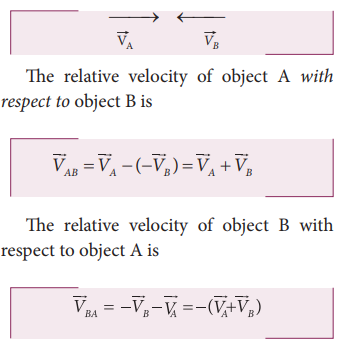
Thus,
if two objects are moving in opposite directions, the magnitude of relative
velocity of one object with respect to other is equal to the sum of magnitude
of their velocities.
Case 3
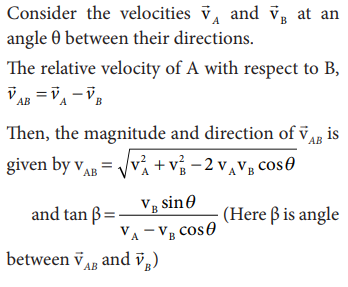
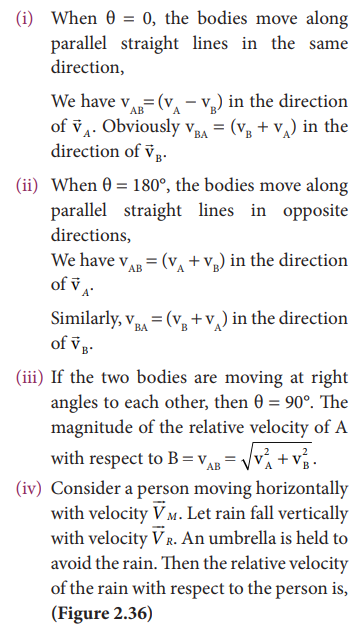
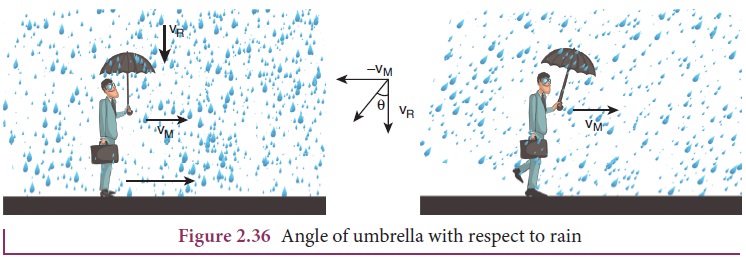
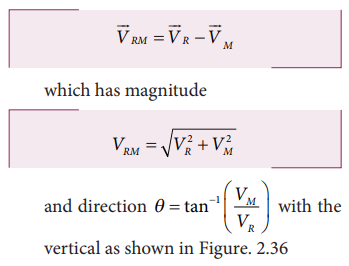
In
order to save himself from the rain, he should hold an umbrella at an angle θ
with the vertical.
Accelerated Motion
During
non-uniform motion of an object, the velocity of the object changes from
instant to instant i.e., the velocity of the object is no more constant but
changes with time. Such a motion is said to be an accelerated motion.
·
In
accelerated motion, if the change in velocity of an object per unit time is
same (constant) then the object is said to be moving with uniformly accelerated
motion.
·
On
the other hand, if the change in velocity per unit time is different at
different times, then the object is said to be moving with non-uniform accelerated
motion.
Average acceleration
If
an object changes its velocity from ![]() to
to ![]() in a time
interval ∆t = t 2 − t 1 ,
then the average acceleration is defined as the ratio of change in velocity
over the time interval ∆t = t 2 − t1
in a time
interval ∆t = t 2 − t 1 ,
then the average acceleration is defined as the ratio of change in velocity
over the time interval ∆t = t 2 − t1

Average
acceleration is a vector quantity in the same direction as the vector ∆![]() .
.
Instantaneous acceleration
Usually,
the average acceleration will give the change in velocity only over the entire
time interval. It will not give value of the acceleration at any instant time
t.
Instantaneous
acceleration or acceleration of a particle at time ‘t’ is given by the ratio of
change in velocity over Δt, as Δt approaches zero.

In
other words, the acceleration of the particle at an instant t is equal to rate
of change of velocity.
i.
Acceleration is a vector quantity. Its SI unit is ms-2
and its dimensional formula is M0L1T-2
ii.
Acceleration is positive if its velocity is increasing, and is negative if the
velocity is decreasing. The negative acceleration is called retardation or
deceleration.
In
terms of components, we can write
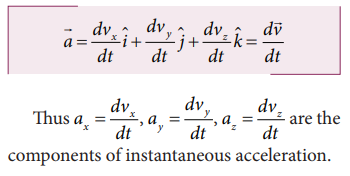
Since
each component of velocity is the derivative of the corresponding coordinate,
we can express the components ax, ay, and az,
as
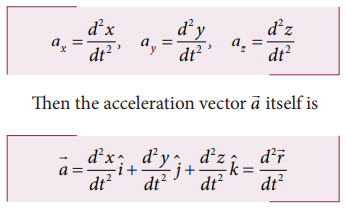
Thus
acceleration is the second derivative of position vector with respect to time.
Graphically
the acceleration is the slope in the velocity-time graph. At the same time if
the acceleration-time graph is given, then the velocity can be found from the
area under the acceleration-time graph.
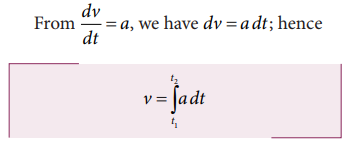
For
an initial time t1 and final time t2
Equations of Uniformly Accelerated Motion by Calculus Method
Consider
an object moving in a straight line with uniform or constant acceleration ‘a’.
Let
u be the velocity of the object at time t = 0, and v
be velocity of the body at a later time t.
Velocity - time relation
(i)
The acceleration of the body at any instant is given by the first derivative of
the velocity with respect to time,

Integrating
both sides with the condition that as time changes from 0 to t, the velocity
changes from u to v. For the constant acceleration,
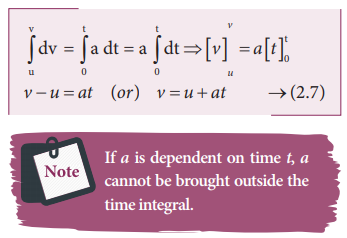
Displacement - time relation
(ii)
The velocity of the body is given by the first derivative of the displacement
with respect to time.
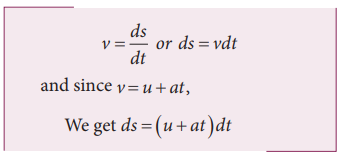
Assume
that initially at time t = 0, the particle started from the
origin. At a later time t, the particle displacement is s. Further assuming
that acceleration is time-independent, we have

Velocity - displacement relation
(iii)
The acceleration is given by the first derivative of velocity with respect to
time.
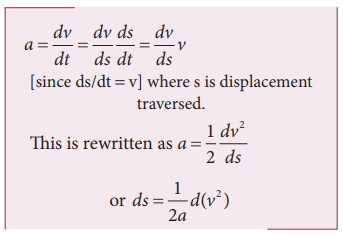
Integrating
the above equation, using the fact when the velocity changes from u2
to v2, displacement changes from 0 to s, we get
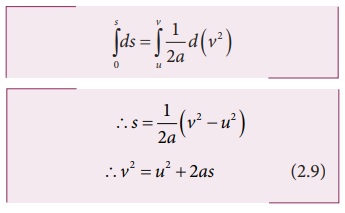
We
can also derive the displacement s in terms of initial velocity u and final
velocity v.
From
the equation (2.7) we can write,

The
equations (2.7), (2.8), (2.9) and (2.10) are called kinematic equations of
motion, and have a wide variety of practical applications.
Kinematic equations
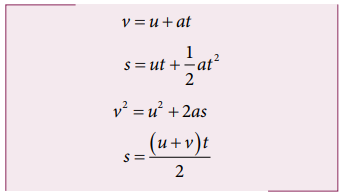
It
is to be noted that all these kinematic equations are valid only if the motion
is in a straight line with constant acceleration. For circular motion and
oscillatory motion these equations are not applicable.
Equations of motion under gravity
A
practical example of a straight line motion with constant acceleration is the
motion of an object near the surface of the Earth. We know that near the
surface of the Earth, the acceleration due to gravity ‘g’ is constant. All
straight line motions under this acceleration can be well understood using the
kinematic equations given earlier.
Case (1): A body falling from a height h

Consider
an object of mass m falling from a height h. Assume there is no air resistance.
For convenience, let us choose the downward direction as positive y-axis as
shown in the Figure 2.37. The object experiences acceleration ‘g’ due to
gravity which is constant near the surface of the Earth. We can use kinematic
equations to explain its motion. We have
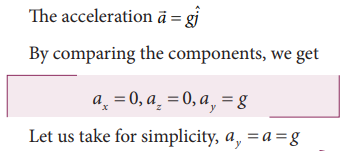
If
the particle is thrown with initial velocity ‘u’ downward which is in negative
y axis, then velocity and position at of the particle any time t is given by

The
square of the speed of the particle when it is at a distance y from the
hill-top, is

Suppose
the particle starts from rest.
Then
u = 0
Then
the velocity v, the position of the particle and v2 at any time t
are given by (for a point y from the hill-top)
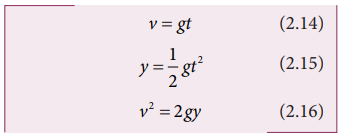
The
time (t = T) taken by the particle to reach the ground (for which y = h), is given by using equation (2.15),

The
equation (2.18) implies that greater the height(h), particle takes more time(T)
to reach the ground. For lesser height(h),
it takes lesser time to reach the ground.
The
speed of the particle when it reaches the ground (y = h) can be found using equation (2.16), we get

The
above equation implies that the body falling from greater height(h) will have higher velocity when it
reaches the ground.
The motion of a body falling towards
the Earth from a small altitude (h << R), purely under the force of
gravity is called free fall.
(Here R is radius of the Earth )
Case (ii): A body thrown vertically upwards
Consider
an object of mass m thrown vertically
upwards with an initial velocity u.
Let us neglect the air friction. In this case we choose the vertical direction
as positive y axis as shown in the Figure 2.38, then the acceleration a =-g (neglect air friction) and g points towards the negative y
axis. The kinematic equations for this motion are,
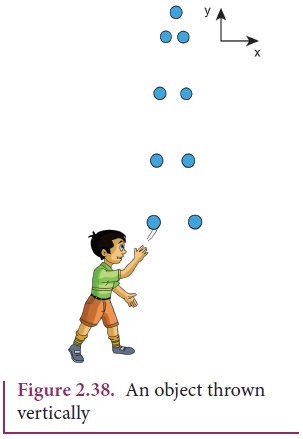
The
velocity and position of the object at any time t are,

The
velocity of the object at any position y (from the point where the object is
thrown) is

Solved Example Problems for Average velocity
Example 2.25
A particle moves along the x-axis in such a way that its coordinates x varies with time 't' according to the equation x = 2 - 5t + 6t2. What is the initial velocity of the particle?
Solution
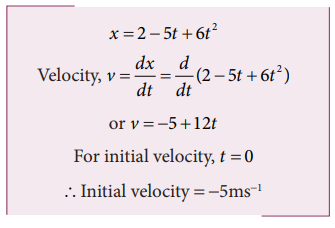
The negative sign implies that at t = 0 the velocity of the particle is along negative x direction.
Solved Example Problems for Relative Velocity in One and Two Dimensional Motion
Example 2.26
Suppose two cars A and B are moving with uniform velocities with respect to ground along parallel tracks and in the same direction. Let the velocities of A and B be 35 km h-1 due east and 40 km h-1 due east respectively. What is the relative velocity of car B with respect to A?
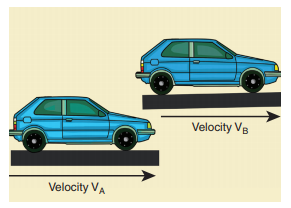
Solution
The relative velocity of B with respect to A,  due east
due east
Similarly, the relative velocity of A with respect to B i.e.,  due west.
due west.
Example 2.27
Suppose two trains A and B are moving with uniform velocities along parallel tracks but in opposite directions. Let the velocity of train A be 40 km h-1 due east and that of train B be 40 km h-1 due west. Calculate the relative velocities of the trains
Solution
Relative velocity of A with respect to B, vAB = 80 km h−1 due east
Thus to a passenger in train B, the train A will appear to move east with a velocity of 80 km h−1
The relative velocity of B with respect to A, VBA = 80 km h−1 due west
To a passenger in train A, the train B will appear to move westwards with a velocity of 80 km h−1
Example 2.28
Consider two trains A and B moving along parallel tracks with the same velocity in the same direction. Let the velocity of each train be 50 km h-1 due east. Calculate the relative velocities of the trains
Solution

Similarly, relative velocity of A with respect to B i.e., vAB is also zero.
Thus each train will appear to be at rest with respect to the other.
Example 2.29
How long will a boy sitting near the window of a train travelling at 36 km h-1 see a train passing by in the opposite direction with a speed of 18 km h-1. The length of the slow-moving train is 90 m.
Solution
The relative velocity of the slow-moving train with respect to the boy is = (36 + 18) km h-1 = 54 km h-1 = = 54 × 5/18 ms-1 = 15 m s-1
Since the boy will watch the full length of the other train, to find the time taken to watch the full train:
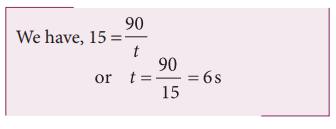
Example 2.30
A swimmer’s speed in the direction of flow of a river is 12 km h-1. Against the direction of flow of the river the swimmer’s speed is 6 km h-1. Calculate the swimmer’s speed in still water and the velocity of the river flow.
Solution
Let vs and vr , represent the velocities of the swimmer and river respectively with respect to ground.
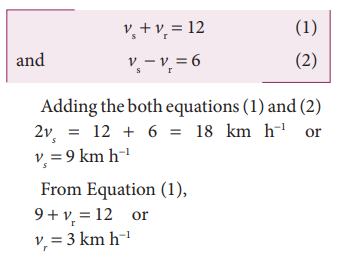
When the river flow and swimmer move in the same direction, the net velocity of swimmer is 12 km p h-1.
Solved Example Problems for Accelerated Motion
Example 2.31
A velocity–time graph is given for a particle moving in x direction, as below
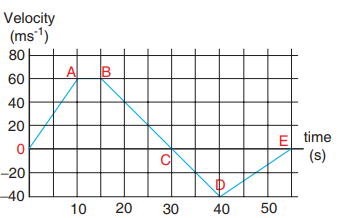
a) Describe the motion qualitatively in the interval 0 to 55 s .
b) Find the distance and displacement travelled from 0 s to 40 s .
c) Find the acceleration at t = 5 s and at t = 20 s
Solution
a) From O to A: (0 s to 10 s )
At t = 0 s the particle has zero velocity.
At t > 0, particle has positive velocity and moves in the positive x direction.
From 0 s to 10 s the slope (dv/dt) positive, implying the particle is accelerating. Thus the velocity increases during this time interval.
From A to B: (10 s to 15 s )
From 10 s to 15 s the velocity stays constant at 60 m s-1. The acceleration is 0 during this period. But the particle continues to travel in the positive x-direction.
From B to C : (15 s to 30 s )
From the 15 s to 30 s the slope is negative, implying the velocity is decreasing. But the particle is moving in the positive x direction. At t = 30 s the velocity becomes zero, and the particle comes to rest momentarily at t = 30 s .
From C to D: (30 s to 40 s )
From 30 s to 40 s the velocity is negative. It implies that the particle starts to move in the negative x direction. The magnitude of velocity increases to a maximum 40 m s-1
From D to E: (40 s to 55 s )
From 40 s to 55 s the velocity is still negative, but starts increasing from –40 m s-1 At t = 55 s the velocity of the particle is zero and particle comes to rest.
(b) The total area under the curve from 0 s to 40 s will give the displacement. Here the area from O to C represents motion along positive x–direction and the area under the graph from C to D represents the particle's motion along negative x–direction.
The displacement travelled by the particle from 0 s to 10 s = 1/2 × 10 × 60 = 300m
The displacement travelled from 10 s to 15 s = 60 × 5 = 300 m
The displacement travelled from 15 s to 30 s =1/2 × 15 × 60 = 450m
The displacement travelled from 30 s to 40 s = 1/2 × 10 × (-40) = -200m.
Here the negative sign implies that the particle travels 200 m in the negative x direction.

300 m + 300 m + 450 m − 200 m = +850 m.
Thus the particle's net displacement is along the positive x-direction.
The total distance travelled by the
particle from 0 s to 40 s = 300 + 300 + 450 + 200 = 1250 m.
(c) The acceleration is given by the slope in the velocity-time graph. In the first 10 seconds the velocity has constant slope (constant acceleration). It implies that the acceleration a is from v1 = 0 to v2 = 60 m s-1.
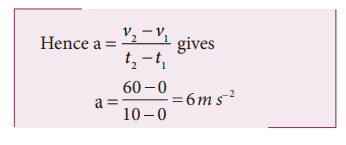
Next, the particle has constant negative slope from 15 s to 30 s . In this case v2=0 and v1=60m s-1. Thus the acceleration at t = 20 s is given by a = (0-60)/(30-15) = 4 m s-2. Here the negative sign implies that the particle has negative acceleration.
Example 2.32
If the position vector of the particle is given by  Find the
Find the
a. The velocity of the particle at t = 3 s
b. Speed of the particle at t = 3 s
c. acceleration of the particle at time t = 3 s
Solution
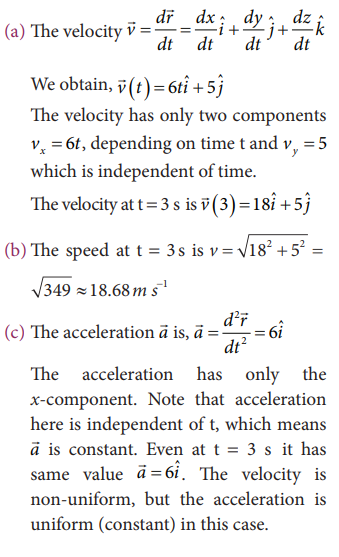
Example 2.33
An object is thrown vertically downward. What is the acceleration experienced by the object?
Solution
We know that when the object falls towards the Earth, it experiences acceleration due to gravity g = 9.8 m s-2 downward. We can choose the coordinate system as shown in the figure.
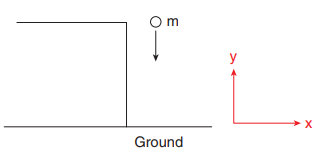
The acceleration is along the negative y direction.

Solved Example Problems for motion under gravity: Case (1): A body falling from a height h
Example 2.34
An iron ball and a feather are both falling from a height of 10 m.
a) What are the time taken by the iron ball and feather to reach the ground?
b) What are the velocities of iron ball and feather when they reach the ground?
(Ignore air resistance and take g = 10 m s-2)
Solution
Since kinematic equations are independent of mass of the object, according to equation (2.8) the time taken by both iron ball and feather to reach the ground are the same. This is given by

Thus, both feather and iron ball reach ground at the same time.
By following equation (2.19) both iron ball and feather reach the Earth with the same speed. It is given by

Example 2.35
Is it possible to measure the depth of a well using kinematic equations?
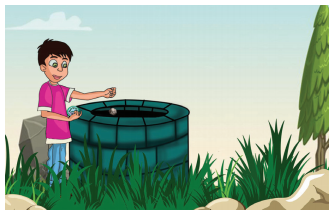
Consider a well without water, of some depth d. Take a small object (for example lemon) and a stopwatch. When you drop the lemon, start the stop watch. As soon as the lemon touches the bottom of the well, stop the watch. Note the time taken by the lemon to reach the bottom and denote the time as t.
Since the initial velocity of lemon u = 0 and the acceleration due to gravity g is constant over the well, we can use the equations of motion for constant acceleration.

Since u = 0, s = d, a = g (Since we choose the y axis downwards), Then

Substituting g = 9.8 m s-2 we get the depth of the well.
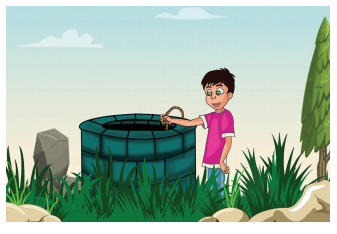
To estimate the error in our calculation we can use another method to measure the depth of the well. Take a long rope and hang the rope inside the well till it touches the bottom. Measure the length of the rope which is the correct depth of the well (dcorrect ). Then
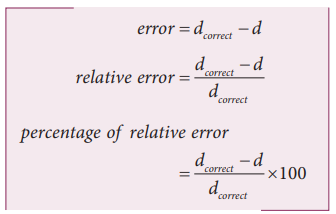
What would be the reason for an error, if any?
Repeat the experiment for different masses and compare the result with dcorrect every time.
Solved Example Problems for motion under gravity: Case (2): A body thrown vertically upwards
Example 2.36
A train was moving at the rate of 54 km h-1 when brakes were applied. It came to rest within a distance of 225 m. Calculate the retardation produced in the train.
Solution
The final velocity of the particle v = 0
The initial velocity of the particle

Retardation is always against the velocity of the particle.

Related Topics